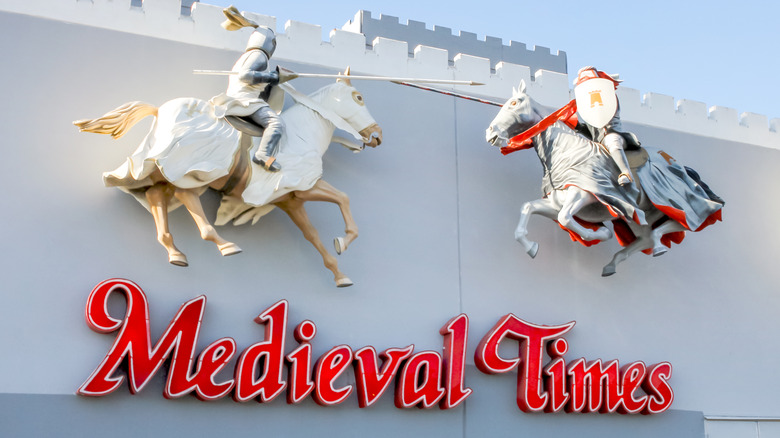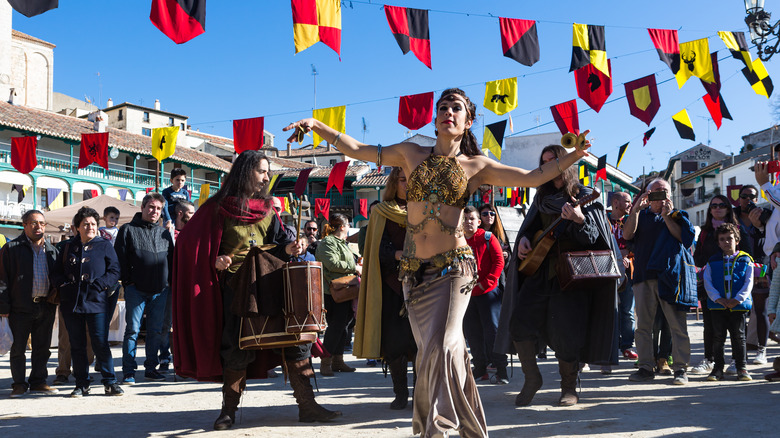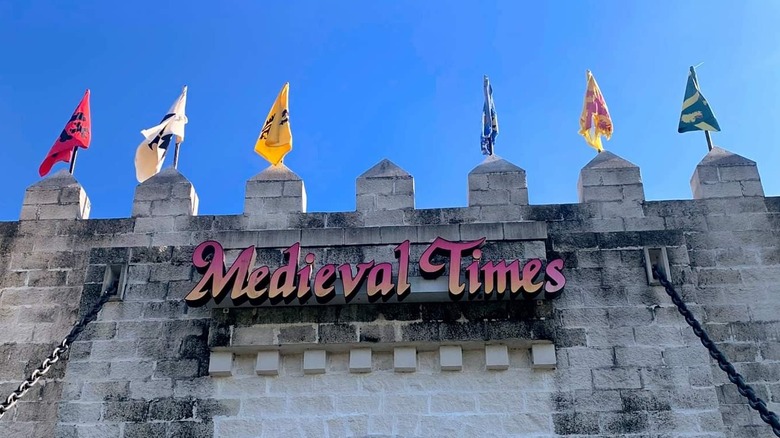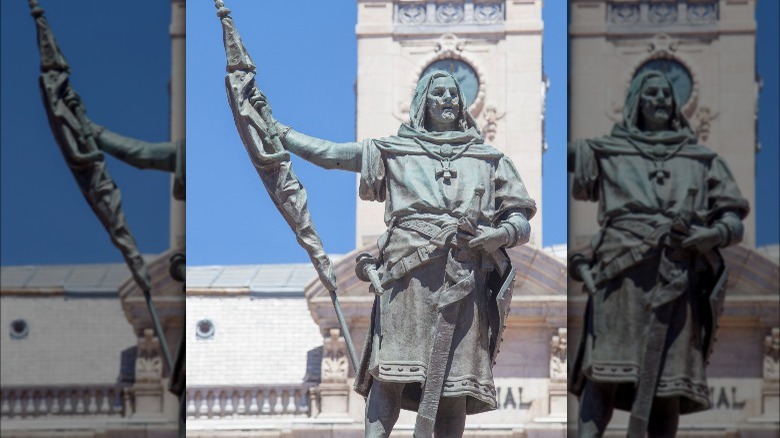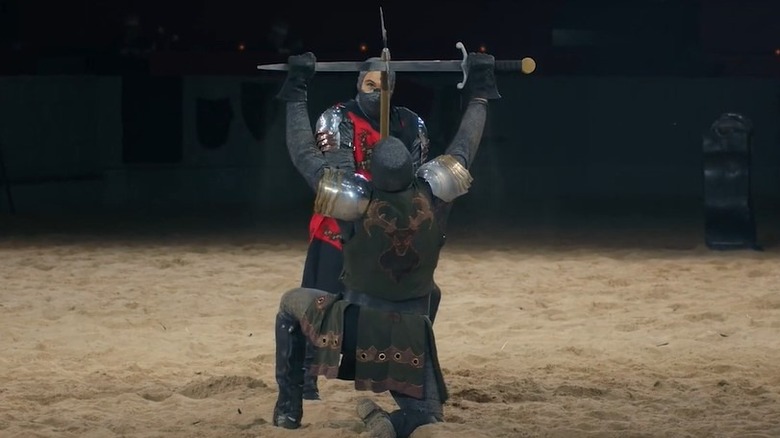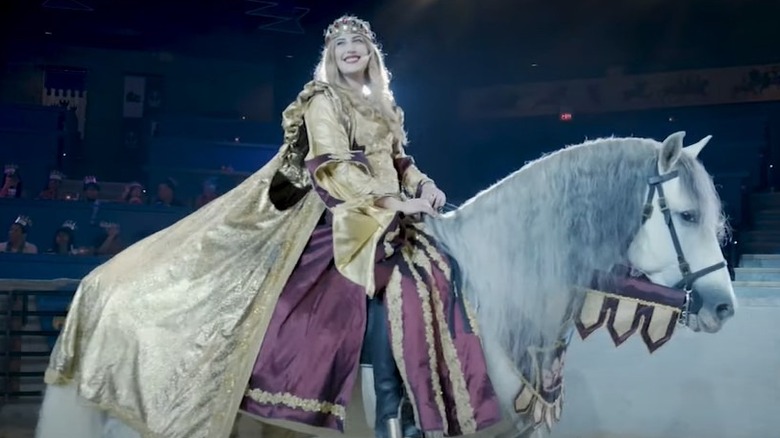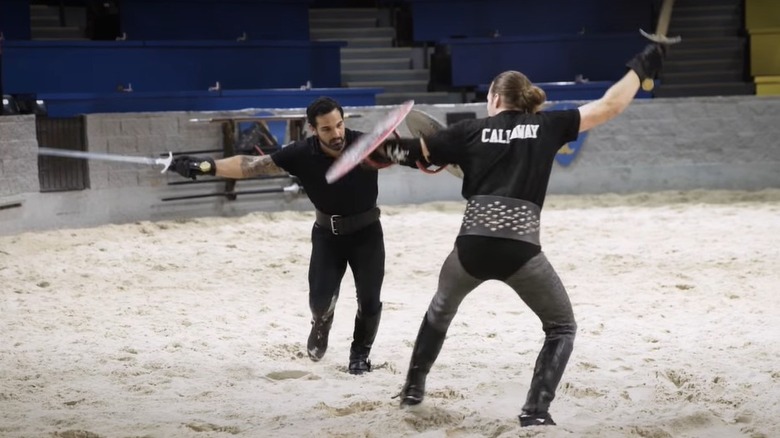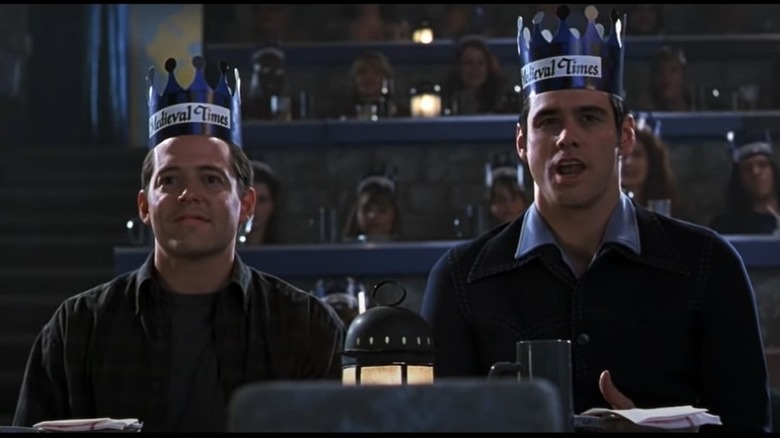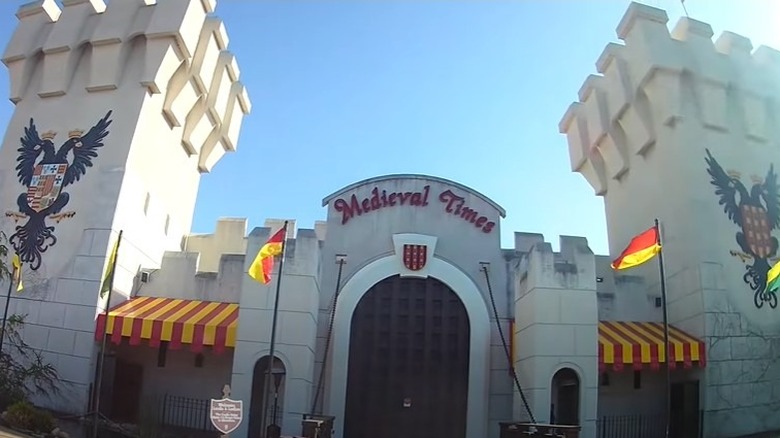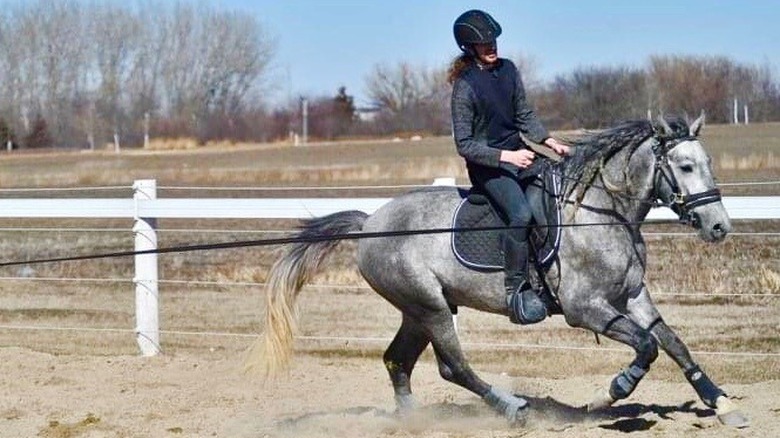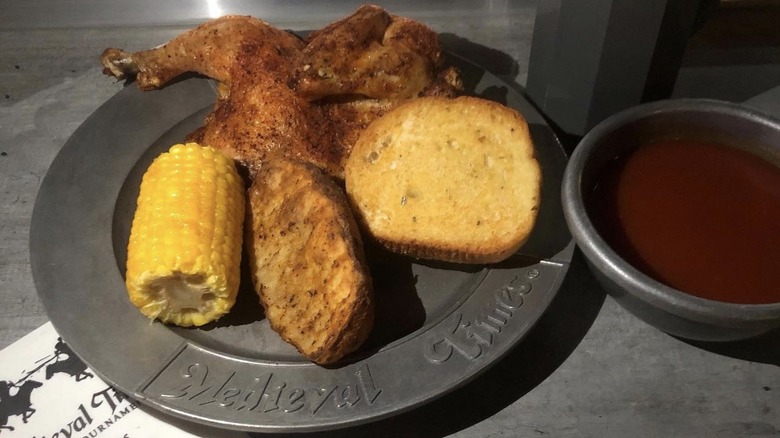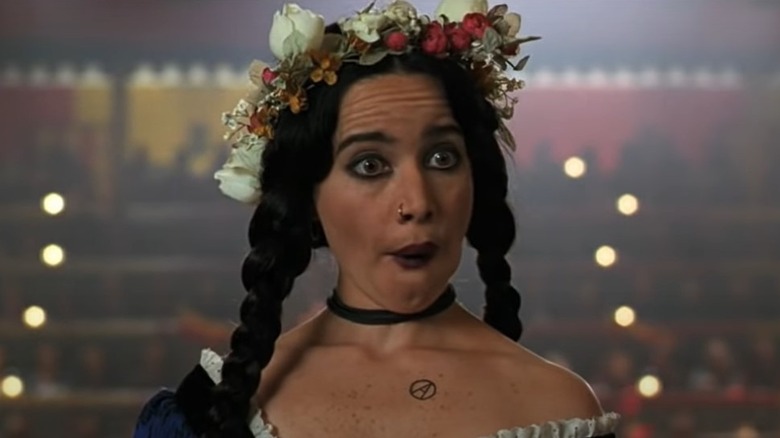The Untold Truth Of Medieval Times
Gather round, ye loyal subjects, and allow us to regale you with an epic tale the likes of which the world has rarely seen. It is a song filled with courageous lords, virtuous ladies, and swashbuckling sword fighters who would stop at nothing short of death to avenge their queen.
Ok, we admit: We may have gotten a little bit carried away just now. But an inclination towards pomp and circumstance is inevitable when you're discussing something as pageant-filled as Medieval Times. A dining experience unlike any other, Medieval Times Dinner & Tournament has been transporting guests back to the 11th century since opening its first U.S. restaurant — or "castle" as the company calls them — in Kissimmee, Florida, in 1983.
When you consider the pop culture impact of shows like "Game of Thrones," it's no surprise that Medieval Times remains a popular alternative to traditional dinner theater. But beyond a desire to provide guests with a truly authentic representation of the Middle Ages, there's a lot you may not know about this one-of-a-kind establishment. So grab yourself a flagon of ale, and prepare to party like it's 1099 as we recite the ballad of Medieval Times — revealing its untold truth to the world.
It was first developed in Spain in the 1960s
With nearly 40 years under its belt as an American landmark, few may realize that Medieval Times wasn't an original U.S. creation. In fact, before opening the first U.S. location in 1983, Spanish restaurateur Jose Montaner opened his first medieval-themed dinner theater on the island of Majorca in the 1960s.
He decided that his restaurant needed something to set it apart from another nearby barbeque joint. To that end, Montaner took inspiration from medieval fairs in England and transformed his venue to appeal to foreign visitors, according to Chicago Tribune. The gamble paid off, and the precursor to the U.S.-based Medieval Times — which soon included a second Spanish location in the town of Benidorm — ran successfully in Spain until the 1980s, when the concept was taken abroad.
Frankly, it only makes sense that Medieval Times traces its lineage back to Europe. After all, not only is the show's storyline based on Spain in the Middle Ages, but portrayals of that entire historical period are very Eurocentric — whether or not that's an accurate or fair depiction.
Its first U.S. castle opened in 1983 in Florida
Starting when Christopher Columbus sailed the ocean blue in 1492, Spain was eager to cross the Atlantic to inhabit the American continents. And Medieval Times is no different, having conquered the North American market (aka the New World) since opening its first U.S. castle in 1983 in Kissimmee, Florida.
Now, it doesn't take a brain surgeon to determine this location was likely chosen for its convenient proximity to Walt Disney World in Orlando. Considering that the first U.S. Medieval Times location is a mere 20 minutes away from the Magic Kingdom park, it's easy to surmise that the company was hoping to pick off Disney tourists eager for a night away from the house of mouse.
Whatever the rationale, the strategic placement of the inaugural Medieval Times restaurant as a neighbor to Disney clearly paid dividends. In 1986, the company opened its second castle in Buena Park, California — again, situated right around the corner from a Disney amusement park — and hasn't looked back since.
It's based on a real 11th-century noble family
It may not be entirely surprising that while Medieval Times strives to create the most authentic recreation of 11th century Spain as possible, there are some liberties taken to accommodate modern audiences. Given this, you may be inclined to scoff at the website's declaration that it presents "authentic Medieval history and ... true story of a noble family ... dating back to the 11th century."
But despite any reservations you may have about its alleged authenticity, there does seem to be at least some truth to the restaurant's claim. The founder of Medieval Times, Jose Montaner, was uncle to the Count of Perelada — a Spanish nobleman with a family history tracing back to (you guessed it) the 11th century. Using a combination of his ancestral story and general research of the time period, Montaner created a reasonable facsimile of medieval Spain.
The Count of Perelada and his historic bloodline didn't end with inspiring the show. The count still held stock in the company as of 2016, and Perico Montaner, son of founder Jose, was still president and CEO of Medieval Times as of 2021.
The combat and competition is scripted like wrestling
Medieval Times' ability to bring to life a world 1000 years in the past is top-notch. The performers are so stellar that it's easy to get caught up in the atmosphere and assume the jousting and sword-fighting participants are actually battling one another. But not unlike the scripted nature of professional wrestling, the knights at Medieval Times are just athletic actors performing highly choreographed and rehearsed routines.
We're sorry to burst your bubble if you harbored hope the knights were truly engaging in bloodlust-driven combat. Aside from the logistical impossibilities such a scenario would create, it's easy to see why a dinner theater would, in fact, involve nothing more than a well-done theatrical performance. Plus, as the company continually emphasizes safety, the show is intricately planned and practiced out of necessity — sufficiently minimizing any potential risks posed by the staged violence.
This commitment to safety can make things a bit monotonous for the performers and occasionally even boring, as Toronto-based yellow knight Alex MacSween said in 2016. Not to say the show itself is boring or that any Joe Schmo can walk off the street and become a knight. After all, since the bare minimum requires aspiring knights to be nimble and fit, as described by the then-chief knight Victor de Lara in 1986 (via LA Times), only the best and brightest can make it to the queen's court.
The first queen in company history was crowned in 2018
Although we've come a long way, women have historically been granted far less autonomy than men — something particularly true during the Middle Ages (via Getty). This unfortunate reality has led Medieval Times, in its quest for verisimilitude, to adopt a number of regressive gender concepts throughout its history. But, in 2018, the company finally broke free from its patriarchal pattern and crowned a queen to lead its royal court for the first time (via Today).
The fact that the restaurant's show changes every few years allowed the writers to make this move. And while Medieval Times' director Leigh Cordner noted to Today that "we're not in politics, we're in show business," it did recognize the importance of elevating a female character to lead the show. Monet Lerner, for instance — or the inaugural queen at the Dallas castle — expressed a desire to "motivate and inspire young women" with her character's ascendence, demonstrating to the world that "there are strong female role models out there."
It may have taken 34 years for Medieval Times to usurp the king for a queen. But now that she's there, all we can say is all hail the queen.
The authentic medieval setting means no utensils, unless you ask
The authenticity of a guest's experience is paramount to the success of Medieval Times. The company is more than aware of this, and its unwillingness to break the fourth wall — or lift the veil, as it were — during a guest's stay is legendary. It's with this in mind that the restaurant does not offer utensils to diners, instead encouraging them to eat with their hands — as they purportedly did during the Middle Ages.
Now, since most medieval individuals used a knife when eating meals, according to Atlas Obscura, it's not entirely accurate to say no cutlery existed during the Middle Ages. But, as University of Wisconsin-Milwaukee historian Martha Carlin notes, "forks did not appear on medieval tables," and people during the Middle Ages were, in fact, "skilled at eating neatly with their hands."
Of course, for those of you turned off by the unsanitary notion of eating with your filth-ridden fingers in public, there's no need to avoid the restaurant. As it clearly states on the website, after all, "silverware is available upon request."
Becoming a knight is harder than you imagine
A key component of the American Dream is that any person willing to work hard and stay focused can accomplish whatever goal they set for themselves. While we're not here to debate the validity of the American Dream in our modern world, we can say that if your dream is to become one of the competing knights at Medieval Times, you'll need to be prepared to work as hard as you've ever worked before.
To become a knight at Medieval Times, a person needs to possess a unique combination of charisma, athleticism, and bravery. Knights are expected to perform in sword and joust fights — which, while choreographed, are still dangerous — as well as become experts in working with, and riding, horses. Not only that, but in order to even be considered for a knight role, you'll have to have apprenticed as a "squire" at Medieval Times extensively beforehand, as mentioned in a 2022 casting call.
Of course, you don't need to take our word that becoming a Medieval Times knight is an enormous undertaking — just check out the 2019 web series chronicling the three-month-long boot camp for future knights at the Scottsdale, Arizona castle.
It endorsed its tongue-in-cheek appearance in The Cable Guy
Coming off an almost-ludicrous string of hits, including "Dumb and Dumber" and "Batman Forever," Jim Carrey was seen as box office gold in 1996. And he was rewarded handsomely as a result, earning an absolutely astounding $20 million dollars, plus 15% of the backend profits for his next film, "The Cable Guy." Now, it's hard to say that the dark comedy — and the almost-defiantly bizarre, committed performance by Carrey — paid off for studio execs. But it may have paid dividends for Medieval Times, which was featured in the film's most memorable scene.
When Carrey's character, Chip, takes customer-turned-forced-friend Steven (Matthew Broderick) to Medieval Times, "The Cable Guy" lovingly pokes fun at the restaurant and its most hardcore fans. The scene, which goes all-in on what people both love and mock about Medieval Times, was actually filmed at the Buena Park castle. This forced the location, normally open 365 days a year, to close for the first time in 10 years to accommodate the production.
The Buena Park staff consulted the cast and crew during filming since the company expected it would boost business, according to Medieval Times spokesman, David Manuel, in the Los Angeles Times in 1996. This allowed for a realistic on-screen depiction that clearly stuck in viewers' minds, playing an undeniable role in expanding the public's awareness of the restaurant, as well as the film's eventual cult status.
There are 10 castles in North America as of 2022
The nature of capitalism often pressures business owners to invest in the growth and expansion of their businesses. Success is dictated by how large a company is or how much it may have grown since first opening. Of course, with 10 total castles in operation in North America as of June 2022 — and having crossed north into Canada in 1993, with its Toronto location — it's clear that Medieval Times is reaching its potential.
With its newest castle, in Scottsdale, Arizona, having opened in 2019, the company was able to stake claim to double-digit locations. While Medieval Times doesn't appear to have any potential plans for further expansion as of 2022, there also aren't any indications that the company is in danger of closing any of its 10 castles, either.
And while the COVID-19 pandemic devastated many restaurants and theaters, Medieval Times was able to navigate the challenging circumstances without shutting down any locations permanently — with all 10 castles eventually reopening to the public.
The animal performers are crucial to the show
If you've ever been to a Medieval Times show, you've likely been enchanted by the prominent presence of both a variety of horse breeds and a flying falcon. Frankly, it wouldn't be the same show without those majestic animals soaring and galloping through the arena — and the company is well aware its show depends on more than just human performers.
Each performance features a falcon-hunting demonstration for spectators and uses up to 22 horses as well. While each show requires a high number of total horses, the company only employs three breeds of "equine entertainers," including the stunning, white-colored Andalusian horse or the pure Spanish horse.
Given the undeniably crucial role its animal performers play in the show, it makes sense that the company would prioritize the animals' well-being — which it does. The animals enjoy a standard of living that many people would envy, according to company spokespeople. This certainly applies to the horses living at Chapel Creek Ranch in Texas, as well as Amadeus the falcon, the Baltimore castle's longest-serving cast member as of 2018.
The four-course meal isn't entirely authentic
There's no doubt that the entertainment factor of Medieval Times is a huge factor in its long-term popularity, though the theater component is only half of the dinner theater concept. Frankly, it's hard to imagine the restaurant succeeding for nearly four decades if the dinner half of its promise didn't deliver as well. We can't deny that its food is indeed a "four-course meal fit for royalty," but Medieval Times' need to please modern palates means it isn't entirely authentic to medieval Spain.
Perhaps the company is owed a bit of leeway here. After all, the world's culinary evolution since the 11th century means we've got an abundance of new techniques and foods that weren't available 1000 years ago. So while the tomato bisque served by the restaurant wouldn't have been available during the Middle Ages — since tomato seeds weren't brought to Europe until 1519 — it's hard to quibble with the company's overall efforts.
More than anything, it seems Medieval Times prioritizes foods that can be eaten with your hands rather than menus that strictly adhere to 11th-century preferences. This is likely why the menu has only seen small changes through the years because significant changes to the core menu would likely render the meals inauthentic, said the corporate director of food service for the Dallas castle, Frank Dameron.
It calls female employees wenches
There's no denying the string of success enjoyed by Medieval Times since its inception, which included a 14% attendance increase in 2013 at the Dallas castle. But while the company's continuous popularity can't really be questioned, its adherence to 11th-century terminology can be — such as the fact that female employees are called "wenches."
Of course, many of the women who work at Medieval Times recognize the term isn't meant to be derogatory. "It's our job to make them customers think that, for this one evening, they're royalty," said employee Vicky Toscano to the Orlando Sentinel in 1988. And as Tabitha Gill stated in 2018, female employees understand that guests generally use the term wench in a spirit of playfulness rather than as a denigrating insult.
Still, not all women enjoy the fun. One employee, Taylor Feehely, told the Washington Post in 2018 that being called a wench can feel degrading — though there's little she or any other employee can do about it. If you're a woman who's determined to work at Medieval Times, that just may be the price you'll have to pay.
